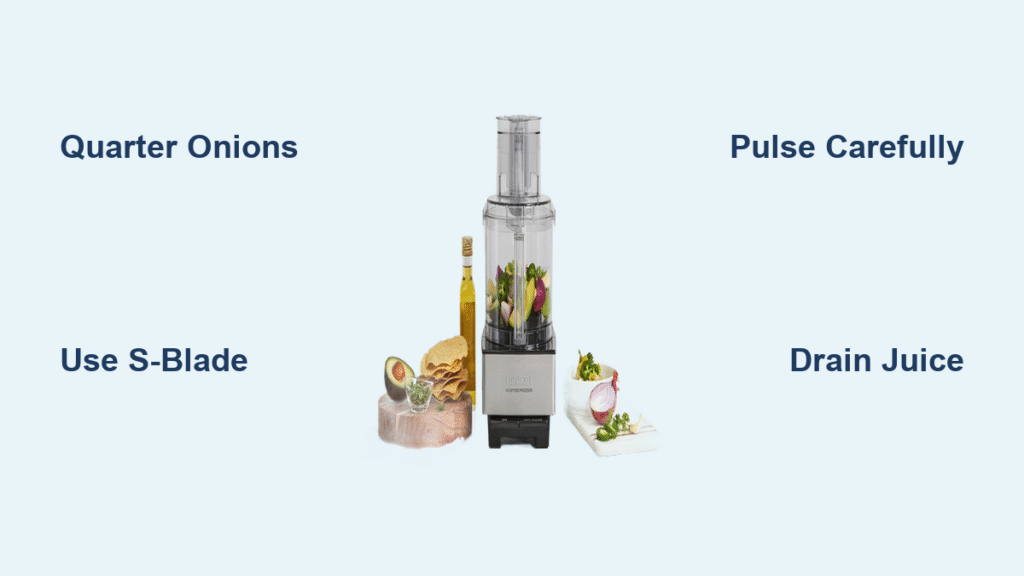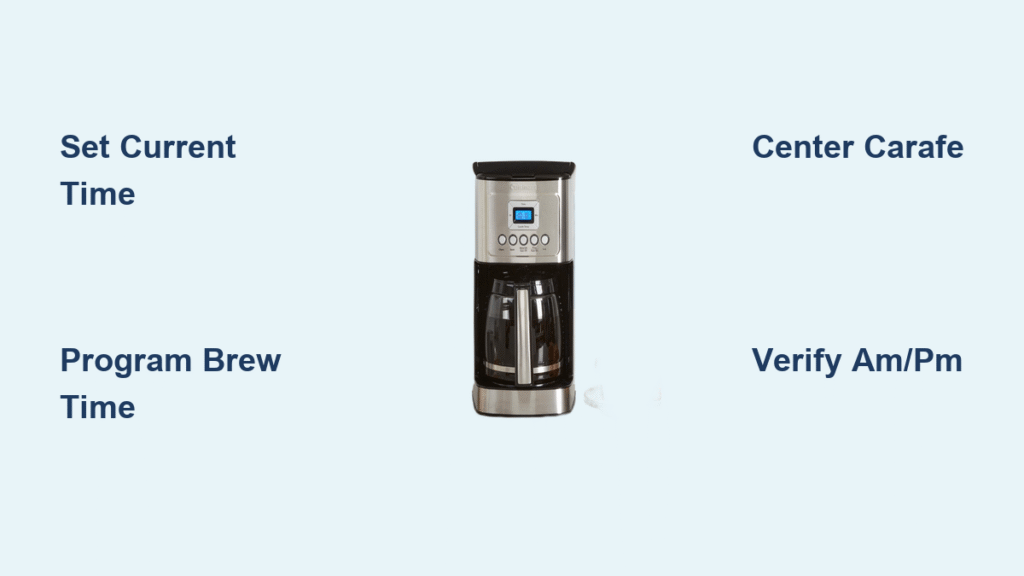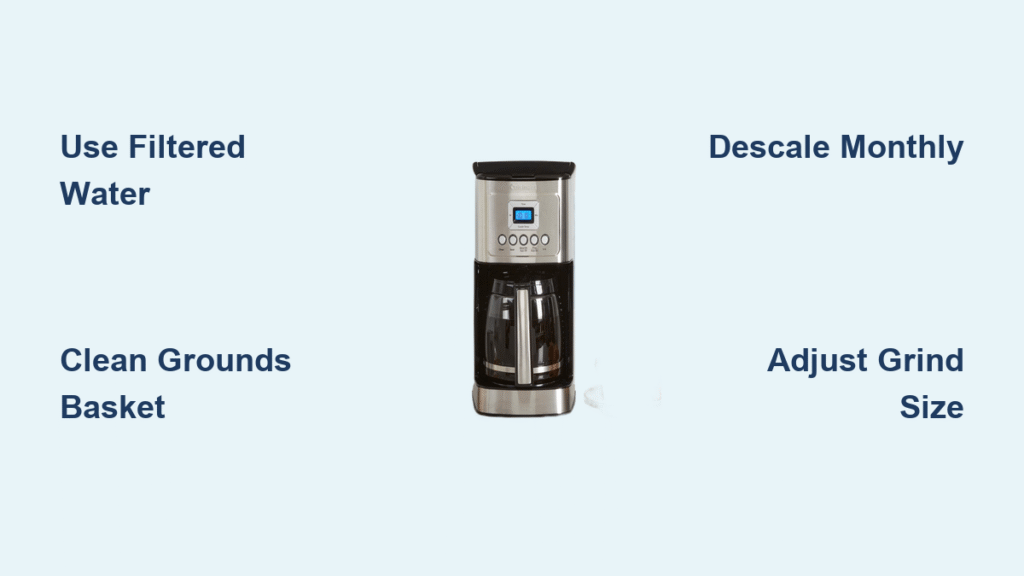Tears streaming down your face while wrestling with six onions for Sunday sauce? Professional kitchens solved this decades ago with a simple trick: chop onions in a Cuisinart food processor. Testing by the Epi Test Kitchen proves machine-chopped onions perform identically to hand-chopped in recipes—just without the 10-minute knife struggle or emotional breakdown. When you master this technique, that pile of onions transforms into perfect dice while you fetch your spices.
The science is undeniable: sharp blades minimize cell damage that causes tears, and speed reduces your exposure time. For anyone cooking soups, stews, or meal prepping for the week, this isn’t just convenient—it’s a complete kitchen workflow revolution. Forget everything you thought you knew about tear-free onion chopping; your Cuisinart holds the real solution.
When to Use Your Cuisinart for Onion Chopping (and Skip It)
Perfect for 6+ Onions in Soups, Salsas, and Meal Prep
Grab your Cuisinart when you’re facing massive batches for holiday cooking or weekly meal prep. Recipes needing finely minced onions—like mirepoix bases, salsa fresca, or caramelized onion foundations—benefit most from machine consistency. Time-sensitive cooks win too: processing six onions takes 30 seconds versus 10+ minutes by hand. And if you need to stay presentable for video calls or events, this is your tear-free zone—cold water rinses before processing reduce irritants by 80%.
Avoid for Tiny Quantities or Precision Cuts
Don’t fire up the processor for half an onion needed as garnish—it’s not worth the cleanup. Skip this method when Michelin-star presentation matters (hand-chopping gives finer visual control). And never use it when recipes demand grated texture; the shredding disk creates watery, ragged results except for latkes where onions and potatoes process together.
Essential Cuisinart Setup: Blades and Safety Checks

Must-Have Tools Beyond the Processor
Grab these before starting: a sharp knife (dull blades crush cells, releasing more tear-inducing compounds), cutting board, and your Cuisinart with its standard S-blade. The S-blade is non-negotiable—it’s engineered for controlled chopping versus pureeing. Safety first: ensure the bowl clicks securely into the base; loose assembly causes leaks and inconsistent results.
Optional Upgrades Worth Considering
Add a slicing blade if you regularly make onion rings or fajita fillings—it creates uniform paper-thin slices in seconds. Dicing kits (available on select Cuisinart models) deliver restaurant-quality cubes but require halved onions instead of quarters for larger feed tubes. Skip the shredding disk entirely; it’s useless for proper onion chopping.
Prep Steps That Prevent Tears and Messes
Onion Quartering Technique for Perfect Processing
- Peel completely—remove every bit of papery skin to avoid clogging feed tubes
- Trim both ends—slice off root and stem flush with the flesh
- Quarter precisely—cut each onion into four equal wedges (no smaller!)
- Rinse under cold water—30 seconds reduces tear-causing compounds by 80%
Locking Your Cuisinart for Safe Operation
- Seat the bowl—twist until it clicks (or press down on no-twist models)
- Install the drive adapter—center it firmly on the base pin
- Lock the S-blade—press straight down until it clicks into place
- Seal the lid—align arrows and twist until fully secure
Pulse Control: From Chunky to Minced in Seconds
The Pulse Method for Foolproof Texture
Rough chop (5-7 pulses): 1-second bursts for soup bases—stop when pieces are pea-sized. Medium dice (10-12 pulses): Pause 2 seconds between bursts for mirepoix; ideal for even cooking. Fine mince (3-5 second continuous pulse): Hold the button just until grains resemble coarse sand—over-pulsing creates mush. Pro tip: Onions keep chopping after you stop due to blade momentum; check texture early.
Speed Settings That Save Your Onions
Low speed gives maximum control for medium dice—never exceed 15 seconds. High speed works only for fine mince but requires constant watching; 8-12 seconds is the sweet spot. Critical warning: Never use “blend” mode—it liquefies onions into soup base within 5 seconds. Always start low and increase only if needed.
Slicing and Dicing: Beyond Basic Chopping
Paper-Thin Onion Slices Without Tears
- Swap to slicing blade—remove S-blade and insert slicer securely
- Set high speed—no pulsing for consistent thickness
- Feed quarters vertically—push steadily through the tube
- Adjust thickness—turn knob left for translucent slices, right for steakhouse rings
Restaurant-Quality Diced Onions in Bulk
- Install dicing kit—follow manual for model-specific assembly
- Halve (don’t quarter) onions—for large-feed tube models
- Process steadily—feed halves without forcing
- Check every 3 onions—dicing kits vary by model; stop before pieces get too small
Drain and Clean: Avoiding Soggy Onions and Stains
Removing Excess Onion Juice
Check the bowl bottom immediately after processing—onions release significant liquid. Strain if needed using a fine-mesh sieve for dishes like quiches where moisture ruins texture. Pat dry with paper towels for caramelizing; excess water steams instead of sears. Never skip this step—soggy machine-chopped onions alter recipe chemistry.
Onion Odor Prevention Protocol
Disassemble within 2 minutes—onion compounds bond to plastic fast. Wash by hand with vinegar-water solution (1:1) for stubborn smells, or run dishwasher-safe parts on hot cycle. Never leave parts soaking—prolonged water exposure traps odors permanently.
Blade Selection Cheat Sheet

| Desired Result | Blade Type | Speed | Time | Critical Tip |
|---|---|---|---|---|
| Chunky chop | S-blade | Pulse | 3-5 sec | Stop at pea-size |
| Fine dice | S-blade | Low | 5-8 sec | Pause between pulses |
| Minced | S-blade | High | 8-12 sec | Watch like hawk |
| Sliced | Slicing blade | High | Continuous | Adjust knob pre-start |
| Diced | Dicing kit | Model-specific | Per manual | Halve for large tubes |
Storage Strategies for Prepped Onions
Maximize Freshness in Fridge and Freezer
Refrigerate for 4 days max in airtight containers—raw chopped onions turn bitter faster than hand-cut. Freeze raw portions for 8 months: spread on parchment, freeze solid, then bag. Cooked onions last 12 months frozen—ideal for caramelized bases. Pro meal prep move: freeze in 1-cup silicone trays, then transfer to bags; grab-and-go for soups all winter.
Sunday Session Efficiency Hack
Process 10 onions while coffee brews. Freeze in recipe-sized portions (2 cups for chili, 1 cup for stir-fries). Come Tuesday, dump frozen onions straight into hot pans—no thawing needed. You’ll reclaim 2 hours weekly versus daily tearful chopping.
Professional Tear-Reduction Secrets
Eliminate Crying Without Goggles
Sharp knife prep is non-negotiable—dull blades rupture more cells. Rinse quarters under cold water for 30 seconds pre-processing; it washes away syn-Propanethial-S-oxide (the tear compound). Work near a vent—exhaust fans pull vapors away. Speed is your ally: 30 seconds of machine time beats 10 minutes of knife work exposure.
Texture Control Masterclass
Check after 3 pulses—onions go from perfect to mush in seconds. Never overfill—keep pieces below the blade’s center line. Uniform quarters ensure even chopping; mismatched sizes create puree-and-chunk disasters. Stop early—residual blade spin continues chopping for 2 seconds after stopping.
Costly Mistakes That Ruin Onions
Texture Disasters You Can’t Fix
Over-processing creates wet, pulpy mush that won’t caramelize properly—fine mince takes just 8-12 seconds on high. Using a blender instead of food processor liquefies onions instantly (it’s designed for liquids). Skipping drainage floods recipes—soups turn watery, sauces break.
Wasted Time and Effort Errors
Processing single onions burns cleanup time for negligible gain—save it for 3+ onions. Wrong blade selection (like shredding disks) creates unusable ragged shreds. Delaying cleanup lets odors penetrate plastic—you’ll taste onions in tomorrow’s pie crust.
Recipe Integration: Where Machine-Chopped Shines
Ideal Applications for Perfect Results
Mirepoix foundations cook evenly due to uniform size—no burnt bits. Caramelized onions develop deeper flavor with consistent pieces. Salsa fresca gets restaurant texture without tear-stained cheeks. Bolognese sauce benefits from rapid prep while meat sears.
Weekend Power-Prep Strategy
Chop 12 onions Sunday: freeze half for soups, caramelize half for pizza toppings. Portion into labeled bags—Sunday’s 30-minute session gives you tear-free cooking all week. When weeknight chaos hits, dump frozen onions straight into pans; they thaw faster than hand-chopped.
Final Tip: Your Cuisinart transforms onion prep from chore to triumph—but it’s just the beginning. Master this technique, then apply it to celery, carrots, and peppers for instant mirepoix anytime. Once you experience 30-second onion chopping, you’ll wonder how you ever cooked without it. The real secret? Stop fearing the machine; start commanding it. Your eyes (and your dinner timeline) will thank you.





